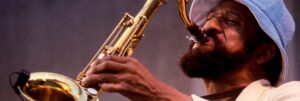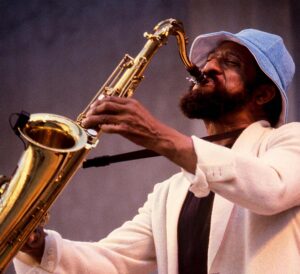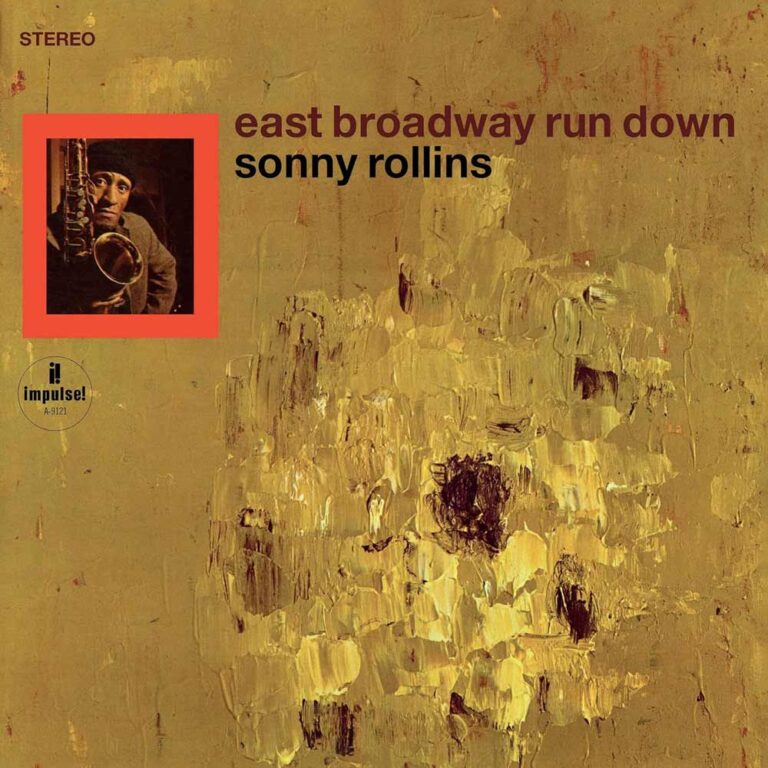One of the more remarkable aspects of Art Kane’s famous ‘A Great Day In Harlem’ photograph –gathering nearly all of American jazz’s major players outside a 125th Street brownstone on 12 August 1958 – is that, at the time of writing, Sonny Rollins is the only survivor.
But then, for many, the musical giant born Theodore Walter Rollins IS jazz. He’s the quintessential searching improviser, the streetwise perfectionist widely seen as the most influential tenor saxist of the modern era alongside Stan Getz, Dexter Gordon and John Coltrane. And yet “East Broadway Run Down”, his third and final official release on Impulse!, recorded at Rudy Van Gelder’s New Jersey studio on 9 May 1966, seems somewhat overlooked. As the years go by, it’s increasingly difficult to ascertain quite why; to the modern jazz fan versed in Coltrane, Kamasi Washington, Shabaka Hutchings or Nubya Garcia, it probably sounds like a classic from the first bar.
By 1966, Rollins was often being compared to Coltrane, but in truth “East Broadway” – despite the presence of JC regulars Elvin Jones on drums and Jimmy Garrison on bass – has very little in common with the music of his friend. Indeed, in a 1978 Downbeat interview, trumpeter Freddie Hubbard – who features strongly on the title track – claims that Rollins stopped a take with the directive: ‘I don’t want any of that Coltrane stuff on my date.’
Perhaps a more relevant reference is Ornette Coleman, particularly regarding the absence of piano on the album. But Rollins had long been experimenting with piano-less trios by 1966, once saying he wanted ‘a drummer for the rhythm and the bass player for the basic harmony, then I had the freedom to do what I wanted to do’. Other links to Coleman on “East Broadway” would be the huge emphasis on the blues and striking use of speech-like saxophone figures.
The title track is a 20-minute tour-de-force featuring a bluesy nine-note phrase, a series of brilliant hide-and-seek games with the rhythm section and some novel tape-echo effects towards the end – predating Teo Macero’s similar production work with Miles Davis by at least three years – when Rollins plays through his horn with the mouthpiece removed. Garrison lays down the strong grooves and striking flamenco-like phrases that have influenced everyone from Charlie Haden to Stanley Clarke.
Side two kicks off with “Blessing In Disguise”, a title that could serve as Sonny’s mantra, another remarkable series of improvisations centred around a catchy five-note phrase. The album closes out with the sublime “We Kiss In A Shadow”, a composition from the musical “The King & I” – even at the height of the avant-garde era, Rollins didn’t abandon standards.
Seldom have Rollins and Jones sounded better – brilliant engineering from Van Gelder lets us hear all the overtones of Sonny’s tenor and Jones’s cymbals. Add to that the gorgeous cover painting by Mel Cheren and Nat Hentoff’s fine liner notes, and “East Broadway” is a formidable package.
So why did Sonny take a third, long sabbatical from jazz after its recording, not releasing anything for six years? His explanation was straight to the point: ‘I was disillusioned with the record business and all of the social turmoil of the time.’ So, in late summer 1967, he travelled to a Mumbai suburb called Powai Lake for four months to study yoga and meditation. A year later, he repaired to Japan for even longer.
By most accounts, his tenure with Impulse! was a mixed experience, though Rollins was fond of producer Bob Thiele and characteristically blamed himself for some business decisions. But these issues didn’t harm the music – just listen.
Read on…How Dexter Gordon created his Masterpiece
Matt Phillips is a London-based writer and musician whose work has appeared in Jazzwise, Classic Pop, Record Collector and The Oldie. He’s the author of “John McLaughlin: From Miles & Mahavishnu To The 4th Dimension”.
Header image: Sonny Rollins. Photo: Ed Perlstein / Redferns via Getty.



